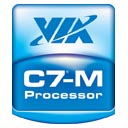VIA C7 (Esther) processors
Introduction: May 2005
Overview
The VIA C7 was an x86 central processing unit designed by Centaur Technology and sold by VIA Technologies. It delivered a number of improvements to the older VIA C3 cores but was nearly identical to the latest VIA C3 Nehemiah core. The C7 was officially launched in May 2005, although according to market reports, full volume production was not in place at that date. In May 2006 Intel's cross-licensing agreement with VIA expired and was not renewed, which was the reason for the forced termination of C3 shipments on March 31, 2006, as VIA lost rights to the socket 370. The C7 appeared still to be found in the marketplace, for example, on the bargain-priced Everex TC2502, sold by Wal-Mart with a Linux distribution preinstalled.
The Esther core
The Esther (C5J) was the next evolution step of the Nehemiah+ (C5P) core of the VIA C3 line-up, including a migration to a 90 nm silicon on insulator (SOI) manufacturing process developed by IBM Microelectronics. The processors were produced in IBM's fab in East Fishkill, New York. The chip was designed by Centaur Technology in Austin, Texas, by a permanent staff of 85 engineers.
Source: Wikipedia, the free encyclopedia.




